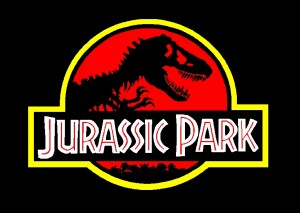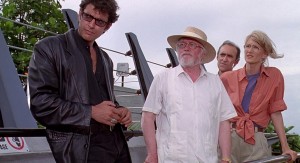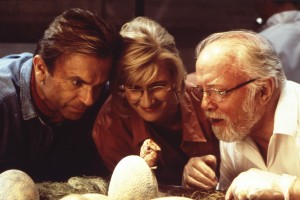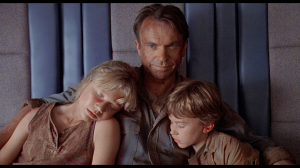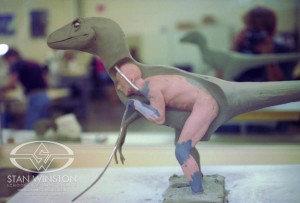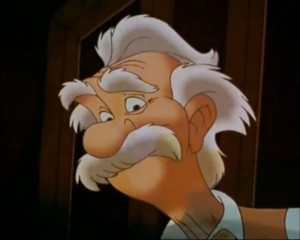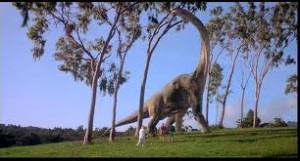100 Film Favorites – #29: Jurassic Park
(Steven Spielberg, 1993)
“I recall the time they found those fossilized mosquitoes,
And before long, they were cloning DNA…”
Today we plunge onward into the “roaring” 20s with probably the greatest “dinosaur movie” to date. In Jurassic Park, a genetic engineering firm led by eccentric billionaire John Hammond has succeeded in creating living dinosaurs, by extracting DNA from fossilized mosquitoes which once fed on the creatures. Hammond plans to showcase his dinosaurs at the titular Jurassic Park, a wildlife preserve located on an island off of Costa Rica. But when a velociraptor kills a park worker, Hammond’s investors grow wary. In order to assuage their fears that the park is unsafe, Hammond opts to bring in some experts to provide testimony in favor of the park’s opening.
At a dig in Montana, paleontologist Alan Grant is overseeing the excavation of a velociraptor skeleton. In some ways Grant is an avowed traditionalist (he has trouble operating machinery and regards dubiously a device which peers through the ground via sonar to reveal buried fossils without digging). But in one respect, Grant’s views are progressive: He believes that many dinosaurs were more closely related to modern day birds than to lizards.
Hammond arrives at the dig to recruit Grant and his MPMM (Maybe Platonic, Maybe More) friend and colleague Ellie Sattler, a paleobotanist, to come review Jurassic Park and hopefully give the resort their seal of approval. The lawyer representing Hammond’s investors comes along on the journey as well, with his own expert, mathematician and chaos theorist Ian Malcolm (Jeff Goldblum) in tow. On the helicopter ride to Costa Rica, Malcolm briefly explains the basics of chaos theory: Complex systems with many variables can produce unexpected (and perhaps uncontrollable) results.
Upon the group’s arrival, Hammond leads a tour of the park’s facilities, beaming with pride over his ambitious endeavor, which “spared no expense.” The guests are shown an animated video which provides a bit of exposition – we learn about the company’s cloning process and how gaps in the dinosaurs’ genetic code were “patched” with snippets of frog DNA. We see a baby velociraptor being born, and then our merry band (which now also includes Hammond’s young grandchildren) depart on a Jeep tour through the park.
The tour is a bust, with the dinosaurs on display either becoming sick or simply not showing up at all. Things go from bad to worse when Dennis Nedry (Wayne Knight, aka NEWMAN!), the head computer programmer behind the park’s security system, enacts a “test” of the system, which really amounts to shutting off many of the resort’s electric fences, allowing him a quick escape. You see, Nedry has been bribed by a rival genetics firm to steal Hammond’s dinosaur embryos,thereby allowing the rival to clone the creatures as well.
Though Nedry is quickly dispatched by a poison-spitting dilosphosaurus, he continues to create major problems for the rest of the cast. Without current in the fence, a mighty Tyrannosaurus escapes its pen and attacks the stalled tour Jeeps. It’s around this point in the film that we begin losing ancillary characters to impressive showings of primordial carnage.
While Ellie and the assorted Jurassic Park technicians attempt to return power to the security systems, Grant must cross the park with Hammond’s grandchildren, Alexis and Tim. Though the cantankerous Dr. Grant starts out the movie resenting children, through his travels with Lex and Tim he warms to them, becoming more paternal and protective.
The engineers’ last-ditch effort to override Nedry’s power-down program has the unintentional effect of turning off electricity to the remaining cages…including the paddock containing the dreaded velociraptors. This sets the stage for a thrilling climax in which the children are pursued by the fast, cunning, and very lethal raptors. In a particularly suspenseful scene, the raptors stalk the kids through the resort’s industrial kitchen (even using their claws to open doorknobs in the process). At the last moment, the rampaging T-Rex swoops in and distracts the raptors. The handful of non-eaten people still remaining rush toward the exit, and Grant informs Hammond that Jurassic Park emphatically does NOT have his seal of approval. Hammond finally concedes that he’s having second thoughts as well. The survivors get airlifted off the island by helicopter, and the film abruptly ends.
Like another Spielberg film, Jaws, Jurassic Park was revolutionary. While 1975’s Jaws popularized the concept of the “summer blockbuster,” Jurassic Park introduced the world to the enormous potential of Computer-Generated Imagery (when it’s used well). Probably the most remarkable feature of the film’s visual effects is that they STILL LOOK GOOD. Relatively speaking, of course, but the visuals on display here far outshine just about any other instance of early 90s computer animation. The staying power of the effects is a result of seamlessly blending multiple forms of animation. Rather than relying solely on computers, much of the film (nearly every medium or close shot) was accomplished with the use of highly intricate animatronics. You can scarcely distinguish a difference between the shots accomplished through the different styles, but as a general rule, if it’s a shot where the whole dinosaur’s body is shown in motion, it’s CGI, but if it’s a close shot or the dinosaur stays primarily stationary, it’s animatronic. For example, in the first T-Rex scene: T-Rex runs after Grant – CGI; T-Rex attacks the car – animatronic; T-Rex eats the lawyer – CGI.
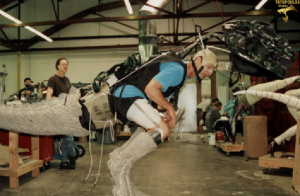 Jurassic Park‘s innovative use of CGI technology made other filmmakers realize that the scope of their films was now truly limited only by the bounds of their imaginations. This was especially great news for George Lucas, who set about working on the CG-soaked Star Wars prequels. It was marginally worse news for anyone who had to watch the Star Wars prequels.
Jurassic Park‘s innovative use of CGI technology made other filmmakers realize that the scope of their films was now truly limited only by the bounds of their imaginations. This was especially great news for George Lucas, who set about working on the CG-soaked Star Wars prequels. It was marginally worse news for anyone who had to watch the Star Wars prequels.
But what really snags “Jurassic Park” such a high-ranking slot on the Countdown is its premise, and the successful realization thereof. The film takes the notion that, thanks to science, dinosaurs may one day walk the Earth again, and makes it seem plausible. So plausible that I could see it succeeding. My one problem with the story of the film (and the novel before it) is the assumption that the park is destined to fail from the beginning. To me, it seems that the Jurassic Park concept probably would have gone off without a hitch if it weren’t for Dennis Nedry deliberately switching off the park’s safety systems.
You might point out that other unexpected, “chaotic” forces were at work which doomed the park, such as the fact that dinosaurs were breeding in the park, despite the alleged impossibility of this feat. I realize this is simply an example of the film’s message that “life will find a way” to circumvent the limitations imposed on it by man, but in reality this particular “circumvention” would not happen. The unexpected breeding occurs as a result of some dinosaurs switching genders, which they could do because the frog species from which came the “filler” DNA in the dinos’ genetic code happened to be sex-swappers as well. But it’s blatantly obvious that author Michael Crichton CHOSE to use frog DNA as the filler code specifically to facilitate this plot twist. Otherwise, it would make more sense to use another source of DNA, such as DNA from birds, which the film seems eager to depict as the evolutionary descendants of dinosaurs. No Nedry, no oddly convenient gender-bending, no problem. Basically what I’m saying is that we could all totally be chilling at live-dinosaur reserves right now if it weren’t for Michael Crichton and his pessimistic view of chaotic systems. I’m holding you responsible for our lack of real dinosaurs, Crichton. You and Captain Neweyes. Seriously, that guy must not be picking me up on his Wish Radio.
Tidbits:
-The dinosaurs were originally going to be depicted not via CGI, but with “Motion Go,” a “realistic” variety of stop-motion animation pioneered by Phil Tippett. This technique adds motion blur to the movements of stop-motion creatures, such as the tauntauns in The Empire Strikes Back. But when Spielberg and Tippett saw preview footage of the dinosaurs rendered in CG, Spielberg remarked, “You’re out of a job.” Tippett responded, “Don’t you mean extinct?” This exchange was incorporated into the film’s script, when Malcolm and Grant muse on the effect that the cloning of live dinosaurs will have on the field of paleontology. It’s somewhat sad to think that this exchange was prophetic, with the advent of CGI putting an end to much major studio stop-motion work.
–Jurassic Park won the 1993 Oscars for Best Visual Effects and Best Sound Editing. The same year, Spielberg, John Williams, and editor Michael Kahn would win Oscars for another film of theirs, Schindler’s List, which also took home Best Picture.
And now for the increasingly common “here’s a heap of semi-related videos” section. Enjoy!
First, here’s a techno remix of the scene in which Hammond’s rival Dodgson bribes Nedry to smuggle him the dinosaur embryos. This is one of those videos that concisely summarizes what the internet is like:
Next, here’s Weird Al’s musical tribute to the film, rendered in another art-form which CGI would largely supplant, claymation:
Finally, let me present another contender for the title of “Best Dinosaur Movie.” It’s Dinosaur Adventure. “What the Hell is going on here?”
—
Brian Terrill is the host of television show Count Gauntly’s Horrors from the Public Domain. You can keep up with Brian’s 100 Film Favorites countdown here.


